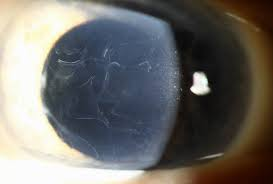What is Epithelial Basement Membrane Disorder (EMBD)?
EBMD is also known as anterior basement membrane disease or map-dot-fingerprint dystrophy. It is a common condition that affects the cornea, the front surface of the eye. The condition usually affects people over 30 years of age and is not easy to diagnose, leaving those affected unaware of their condition. Some people with the disease have subtle corneal irritation that is short-lived while others may have chronic symptoms that are bothersome all the time.

EBMD is a disorder of the basal epithelial cells located in the front part of the cornea. In EBMD, the epithelial cells to become loosely attached to the layer below known as Bowmans membrane. The changes will cause an uneven appearance of maps, dots, and fingerprints within the cornea. These characteristic changes can only be seen with the use of a slit lamp biomicroscope by your eye doctor.
People with EBMD may complain of the following symptoms:
- Fluctuating vision
- Blurred vision
- Intermittent pain
- Acute pain upon waking
Treatment
Treatment of EBMD in people who do not have apparent symptoms include using artificial tears several times per day to encourage optimal epithelial cell health. People with more noticeable symptoms require more frequent use of artificial tears, and bland eye ointments used before bedtime. If there is a history of dry eye, punctal occlusion is also recommended. Punctal occlusion involves inserting a small collagen or silicone plug in the tear drainage canal of the eye to conserve the patient’s tears. Moisture chamber goggles may also be part of the treatment plan to prevent dryness from occurring at night.
In moderate to severe cases, doctors will recommend a hypertonic eye drop or ointment during the day and at night which is a salt solution that draws the fluid out of the cornea, reducing swelling. This helps the epithelial cells stay more tightly adhered to the cornea. Occasionally, doctors will use soft contact lenses to smooth out the cornea.
In cases where other surgeries that rely on the regularity of the corneal surface for a good outcome, such as cataract surgery, a minor procedure may be recommended. This procedure is called corneal curettage or corneal debridement.
Corneal Curettage
During this procedure, the epithelium is removed so a new healthy layer of epithelium can replace it. The surface underneath is polished with a diamond burr. The smooth corneal surface is covered with an amniotic membrane to help promote healing.



